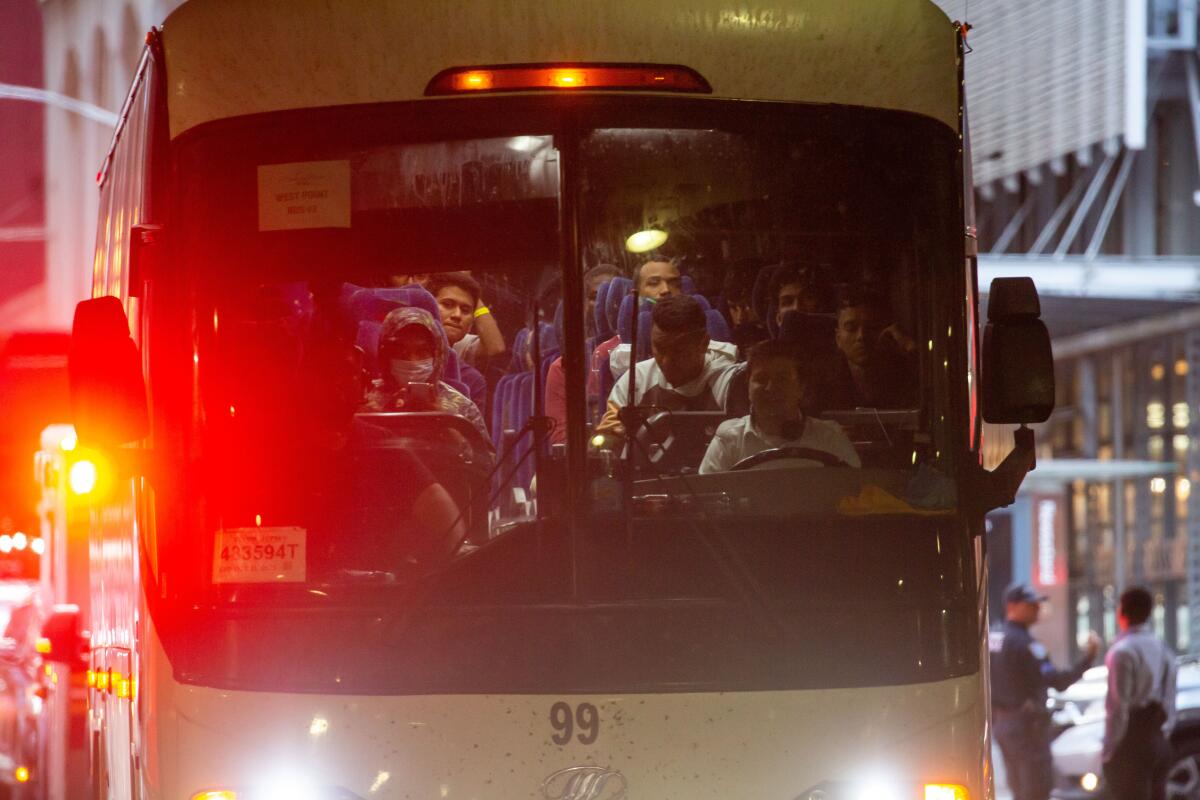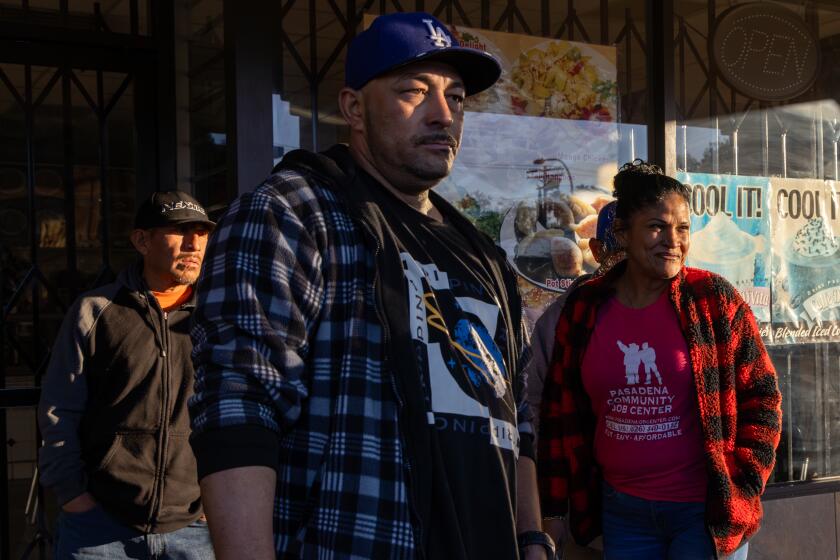What rising immigration really means for California’s economy

WASHINGTON — Even as busloads of migrants sent north by border-state officials have strained cities and stirred new political firestorms in Washington, fresh data are driving home the increasingly crucial role that immigrants will play for U.S. businesses and the economy at large, especially in California.
Net immigration to the U.S. hit a 22-year high of 1.14 million last year, newly released Census Bureau data show. California’s overall population, which lost 75,000 people between July 2022 and July 2023, would have fallen by more than 225,000 if not for international migration, according to calculations by Brookings demographer William Frey.
And that resurgence of immigration has not only given the U.S. a modest gain in total population but also done something far more vital for the economy: It has fueled the nation’s workforce in the last year.
Foreign-born people ages 16 and older account for about 18% of the U.S. working-age population, but they accounted for more than 60% of the country’s labor force growth last year, according to the Bureau of Labor Statistics.
As the overall population ages, as more baby boomers retire, and as family birthrates remain relatively low, the size of the U.S. workforce is increasingly dependent on immigration. That’s especially so in California because it has been losing many residents to other states, including more recently wealthier and higher-income people.
In a reversal from past decades, more college graduates and professionals are moving out of California than coming into it to escape the higher taxes and cost of living.
Better technology can help increase productivity, but if the U.S. economy is to keep growing and offering the possibility of higher standards of living for more of its citizens, an expanding workforce is also vital, most economists agree.
Last Friday’s jobs report for December, while showing resilient employment growth, offered new signs that the economy may be hitting a wall in terms of workforce participation and the return of those who dropped out of the labor market amid the pandemic.
But the same report showed a rising tide of foreign-born workers, including many more who appear to be on the sidelines of the labor market.
“There may be a larger shadow pool of available workers than is generally perceived,” said Bob Schwartz, a senior economist at Oxford Economics in New York. He said an expanding supply of workers could help cool wage growth, an important factor in inflation.
Although illegal immigration and in recent months the out-of-control influx from the southern border have drawn all the attention, as many in Latin America flee violence and poverty, new arrivals to the U.S. have come from many corners of the world, including more migrants from Africa and refugees from Ukraine, among other countries.
Taken together, they could provide additional breathing room to an economy strapped for workers.
Immigrants in the U.S. report high levels of on-the-job discrimination. Among those who are likely undocumented, it’s even worse.
That underlying reality could now begin to break up the political stalemate over immigration, in which Republicans have demanded drastic action to curb immigration while Democrats have been equally adamant about opposing crackdowns.
What may force both sides to begin thinking about compromise is that both broadly conservative business leaders and often liberal big city mayors and state officials are starting to feel the pinch of the labor shortage.
Without much public fanfare, President Biden and many congressional Democrats are being pressed by mayors and other leaders in New York, Denver, Chicago and other cities to tighten up as they’ve been awash in expensive-to-care-for migrants sent by Texas and other border states.
Meantime, all but the most extreme right-wing Republicans in Congress are being quietly urged by some business leaders to loosen up because of worker shortages.

Subscribers get exclusive access to this story
We’re offering L.A. Times subscribers special access to our best journalism. Thank you for your support.
Explore more Subscriber Exclusive content.
“This is a clear case of right-wing Republicans being at odds with the business sector,” said Dean Baker, a senior economist at the Center for Economic and Policy Research, a left-leaning think tank in Washington.
Businesses have reported persistent difficulty finding workers. The National Federation of Independent Business’ December survey found 40% of small-business owners had job openings they couldn’t fill. The problem was especially acute in construction and transportation, but hospitality and health services also have many entry-level openings that analysts say could be filled relatively quickly by immigrants, who tend to be younger and highly motivated to work.
Business and political leaders, in fact, have been urging Washington to provide work authorization, among other help, to deal with the financial and social burden of sheltering the migrant surge.
Conservatives have often argued that immigrants take jobs from U.S. citizens and depress wages for everyone. Although there’s some evidence that large-scale international migration may put downward pressure on some lower-wage jobs, most analysts agree that immigration, historically, has proved to be a net plus for the U.S. economy, increasing consumption and lending vitality and entrepreneurial energy.
More and more young immigrants without legal status are turning to entrepreneurship.
For the foreseeable future, experts say immigration could make the difference between whether the nation’s population is growing or shrinking. And it could be pivotal for many employers as well.
“It allows businesses to expand. A lot of businesses close because they can’t get workers,” Baker said.
The U.S. jobless rate in December was 3.7%, near a 50-year low. And although job openings and worker quits are down from highs, there are still 1.6 unfilled positions for every unemployed person.
The labor participation rate hasn’t quite returned to pre-pandemic levels. The share of working-age people who are either employed or looking for jobs was 62.5% last month, compared with 63.3% on the eve of the pandemic in late 2019.
Nicholas Eberstadt, a political economist at the American Enterprise Institute, a right-leaning think tank in Washington, said female employment is setting records. But many workers 55 and older haven’t returned as previously expected, he said, and the work rate of prime-age men remains as low as the depressed level in 1983.
After four day laborers were hired to dump bags of body parts, others recount stories of strange, and sometimes illegal, jobs they were hired to do.
“Immigration has been very positive for the U.S.,” he said, noting that he favors legal immigration. “The difficulty at the moment is the chaos on the southern border. ... What I worry about is that it’s going to poison public support for immigration.”
That chaos is largely the result of political paralysis in Washington. In a presidential election year in which the battle lines are as bitterly entrenched as they are today, the immediate outlook for compromise may still look dim. But the accumulating data on worker shortages and weak population growth suggest that change may be closer than it looks.
More to Read
Subscriber Exclusive Alert
If you're an L.A. Times subscriber, you can sign up to get alerts about early or entirely exclusive content.
You may occasionally receive promotional content from the Los Angeles Times.















